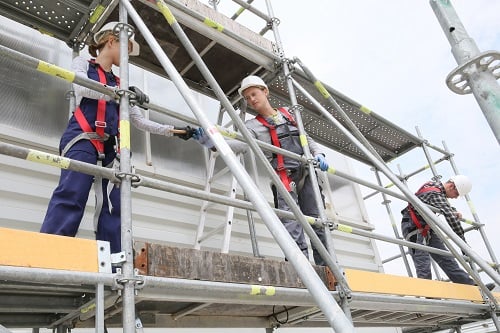Fall Arrest System
What is a Fall Arrest System?
A fall arrest system is a safety system that consists of different components designed to protect workers from the risk of falls. It is built to protect employees working at heights, such as construction sites, warehouses, and rooftops.
A fall arrest system works by stopping a fall within inches, minimising the impact force on the body, and preventing potentially fatal injuries.
The system consists of various elements, including a harness, lanyard, and anchor point. The harness is worn by the worker and is connected to the lanyard, which is in turn connected to the anchor point.
The anchor point is secured to a sturdy object such as a beam, column, or post. The purpose of the system is to prevent the worker from falling should they accidentally slip or lose their balance.
 Fall arrest systems are vital if your workers are working at heights. Are you compliant?
Fall arrest systems are vital if your workers are working at heights. Are you compliant?
How Does a Fall Arrest System Work?
If a worker falls while wearing a fall arrest system, the lanyard will activate and stop the fall. The lanyard is designed to absorb the force of the fall and limit the amount of force that is transferred to the worker’s body.
The harness is also designed to distribute the force of the fall across the body, reducing the risk of injury. The anchor point is critical because it needs to be capable of supporting the weight of the worker and any additional equipment that they may be carrying.
Types of Fall Arrest Systems
There are a variety of fall arrest systems in use today, such as:
Personal Fall Arrest System (PFAS)
The most common type of fall protection system is the personal fall arrest system. It is made of a harness, a lanyard, and an anchor.
The harness is worn by the worker to secure themselves. The lanyard connects the harness to the anchor, typically a secure point like a roof or a platform.
The anchor supports the lanyard and the worker. This system is ideal for anyone working at height.
Guardrail System
Guardrail systems are one of the most popular types of fall arrest systems that protect workers from falls. They're easy to install and provide a physical barrier for the worker to lean on.
Unlike a PFAS, a guardrail system doesn’t require any personal protective equipment. This system is perfect for rooftops and other areas where workers need to work for longer periods.
Netting System
Another common type of fall arrest system is the netting system. It is ideal for jobs where workers can have additional defects even while using a PFAS.
A netting system involves a series of nets strung up to catch an individual in case they fall. This system is intended for use in jobs that require a great deal of mobility.
Safety Cages
A safety cage is a protective barrier that can be fixed to ladder access points. It would help reduce risk hence prevent severe injury or harm to workers due to a fall.
The cage restricts and contains the worker, providing a stop-gap for any fall while providing some comfort. It is used when working with ladders to cut down trees or when working on tall buildings.
Continuous Fall Protection System
A continuous fall protection system is a combination of the other four systems. It's composed of multiple successively connected fixed anchors, using lines, fall protection devices, and engineered systems.
It meets the need of mobile workers and offers continuous and uninterrupted protection from multiple angles.
Key Components of a Fall Arrest System
The components of a fall arrest system include the following:
- Anchorage: The anchorage point is where the lifeline (the rope or cable that the worker uses to connect to the anchorage point) is connected. This component should always be capable of sustaining more weight than the weight of the person using it.
- Body harness: This component is the part of the system that the worker wears. It is responsible for distributing the impact of any fall evenly over the body, thus preventing severe injuries.
- Lifeline: The lifeline is the component that connects the body harness to the anchorage point. It is used to keep the worker from falling too far.
- Shock absorber: Some fall arrest systems may have a shock absorber located in the lifeline. This component is used to reduce the impact on the body that can be caused by sudden stops during a fall.
Use EcoOnline to Manage Fall Arrest Systems
EcoOnline is a workplace safety reporting tool that companies can use to better manage the safety systems they have in place. It can help companies manage existing fall arrest systems in place by tracking regular maintenance schedules and making sure that all fall arrest systems are working effectively.